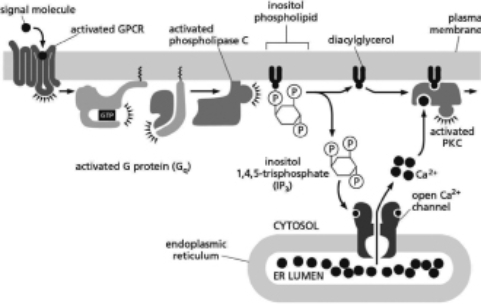Activated protein kinase C (PKC) can lead to the modification of the membrane lipids in the vicinity of the active PKC.Figure 16-17 shows how G proteins can indirectly activate PKC.You have discovered the enzyme activated by PKC that mediates the lipid modification.You call the enzyme Rafty and demonstrate that activated PKC directly phosphorylates Rafty, activating it to modify the plasma membrane lipids in the vicinity of the cell where PKC is active; these lipid modifications can be detected by dyes that bind to the modified lipids.Cells lacking Rafty do not have these modifications, even when PKC is active.Which of the following conditions would lead to signal-independent modification of the membrane lipids by Rafty?  Figure 16-17
Figure 16-17
A) the expression of a constitutively active phospholipase C
B) a mutation in the GPCR that binds the signal more tightly
C) a Ca2+ channel in the endoplasmic reticulum with an increased affinity for IP3
D) a mutation in the gene that encodes Rafty such that the enzyme can no longer be phosphorylated by PKC
Correct Answer:
Verified
Q1: During the mating process, yeast cells
Q2: Which of the following statements about G-protein-coupled
Q3: Acetylcholine binds to a GPCR on heart
Q4: Foreign substances like nicotine, morphine, and menthol
Q6: The lab you work in has discovered
Q7: You are interested in how cyclic-AMP-dependent protein
Q8: Which of the following statements about molecular
Q9: Which of the following statements is TRUE?
A)Extracellular
Q10: Adrenaline stimulates glycogen breakdown in skeletal muscle
Q11: Which of the following statements is TRUE?
A)Because
Unlock this Answer For Free Now!
View this answer and more for free by performing one of the following actions

Scan the QR code to install the App and get 2 free unlocks

Unlock quizzes for free by uploading documents